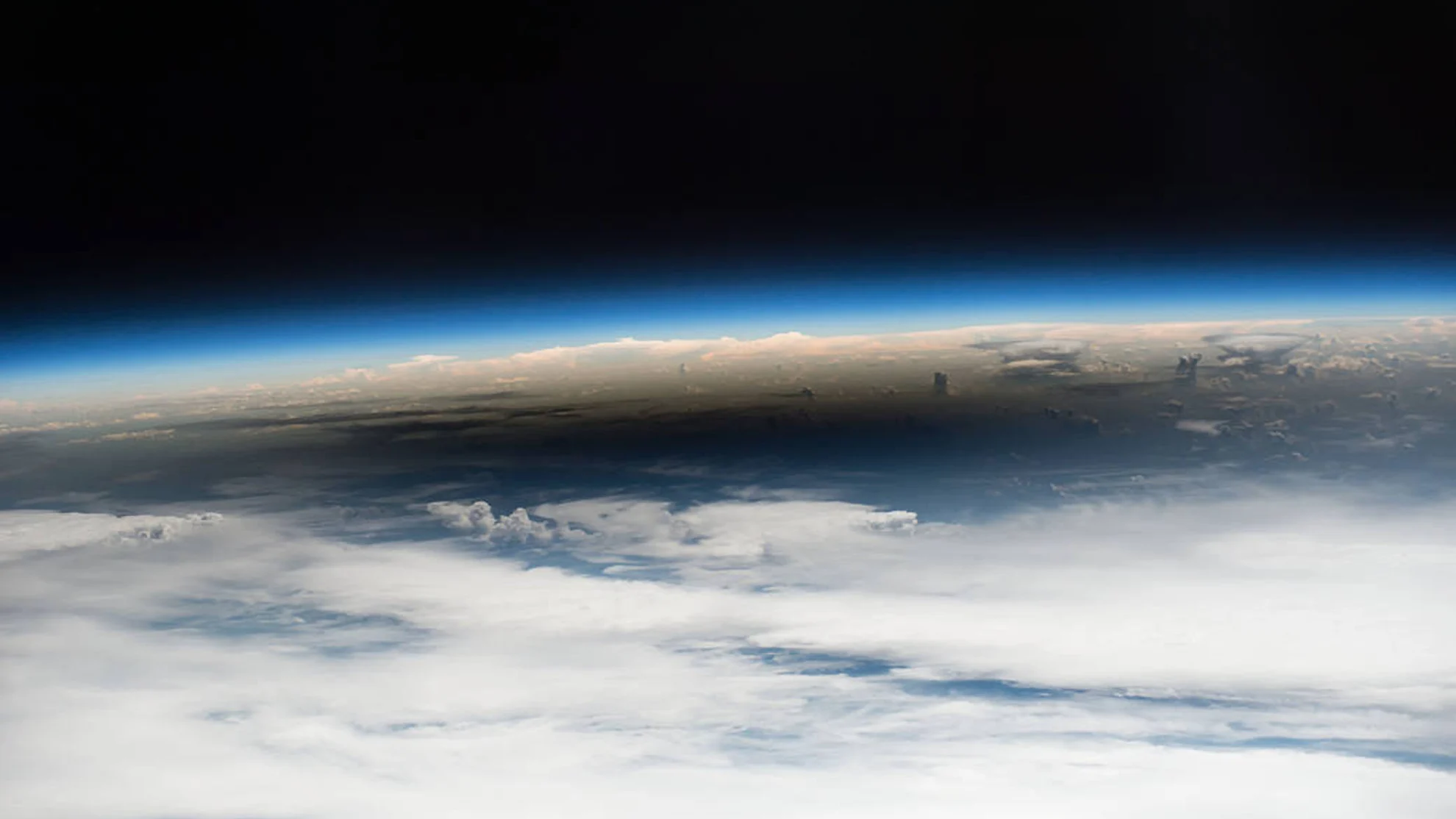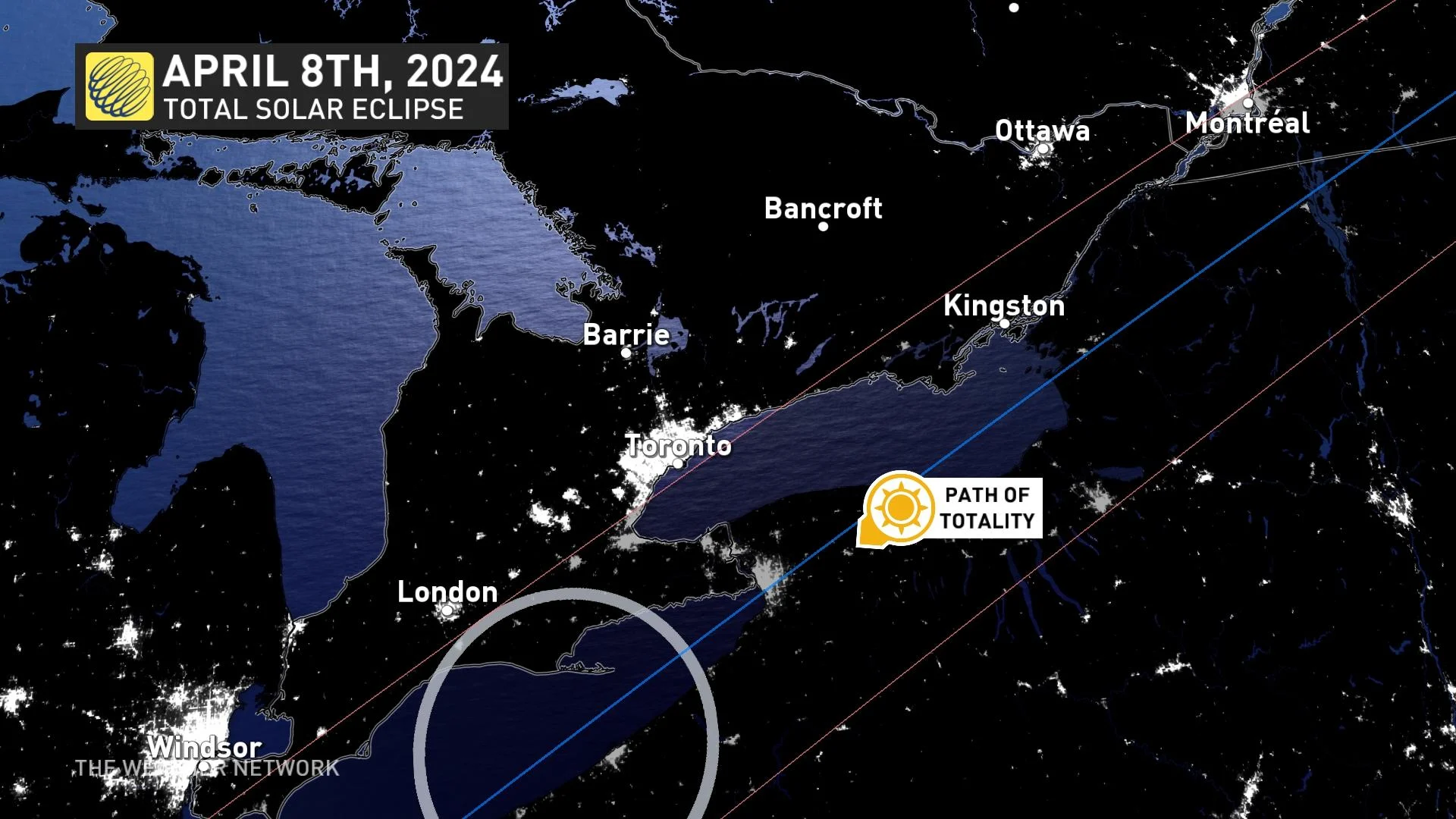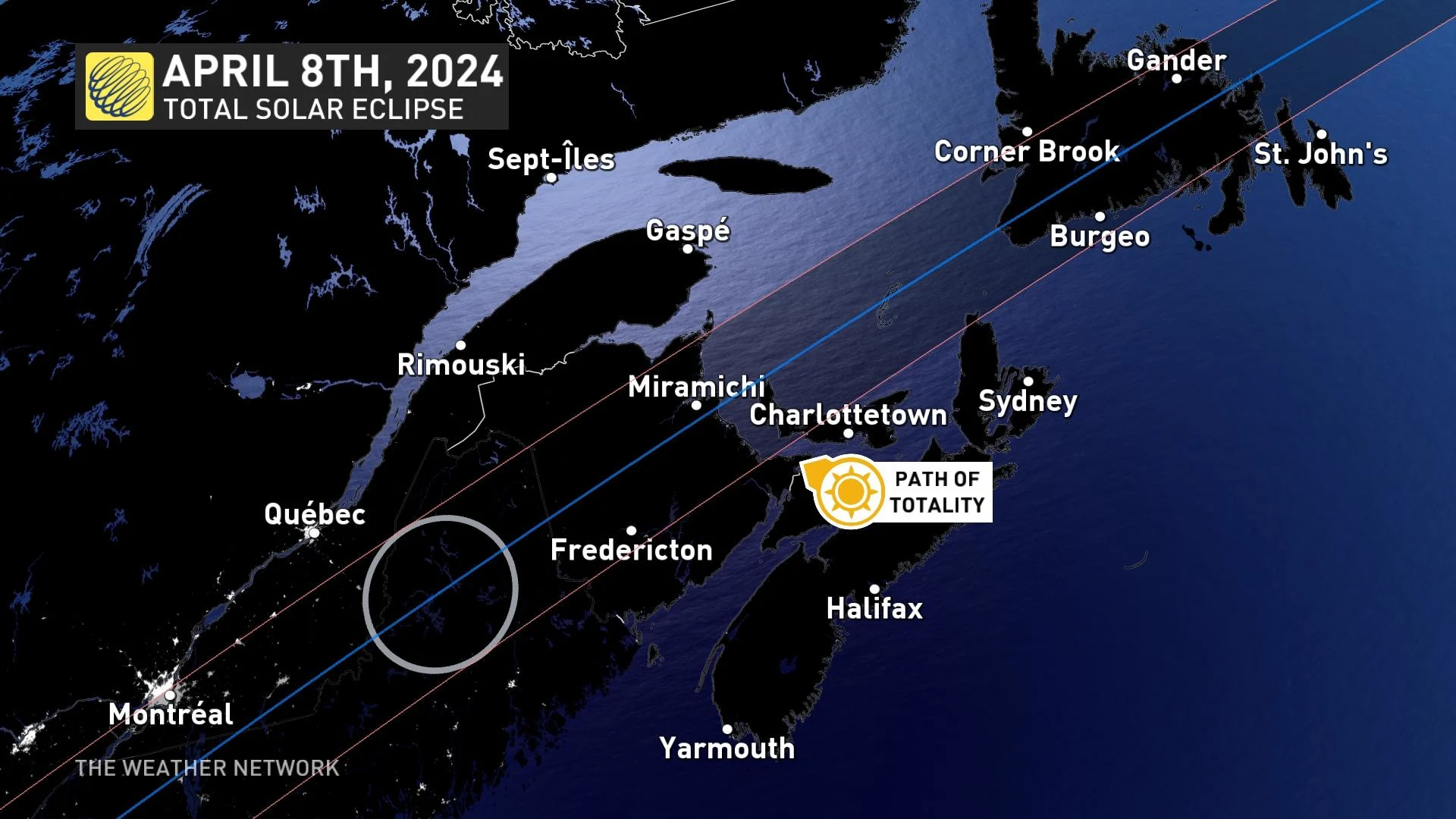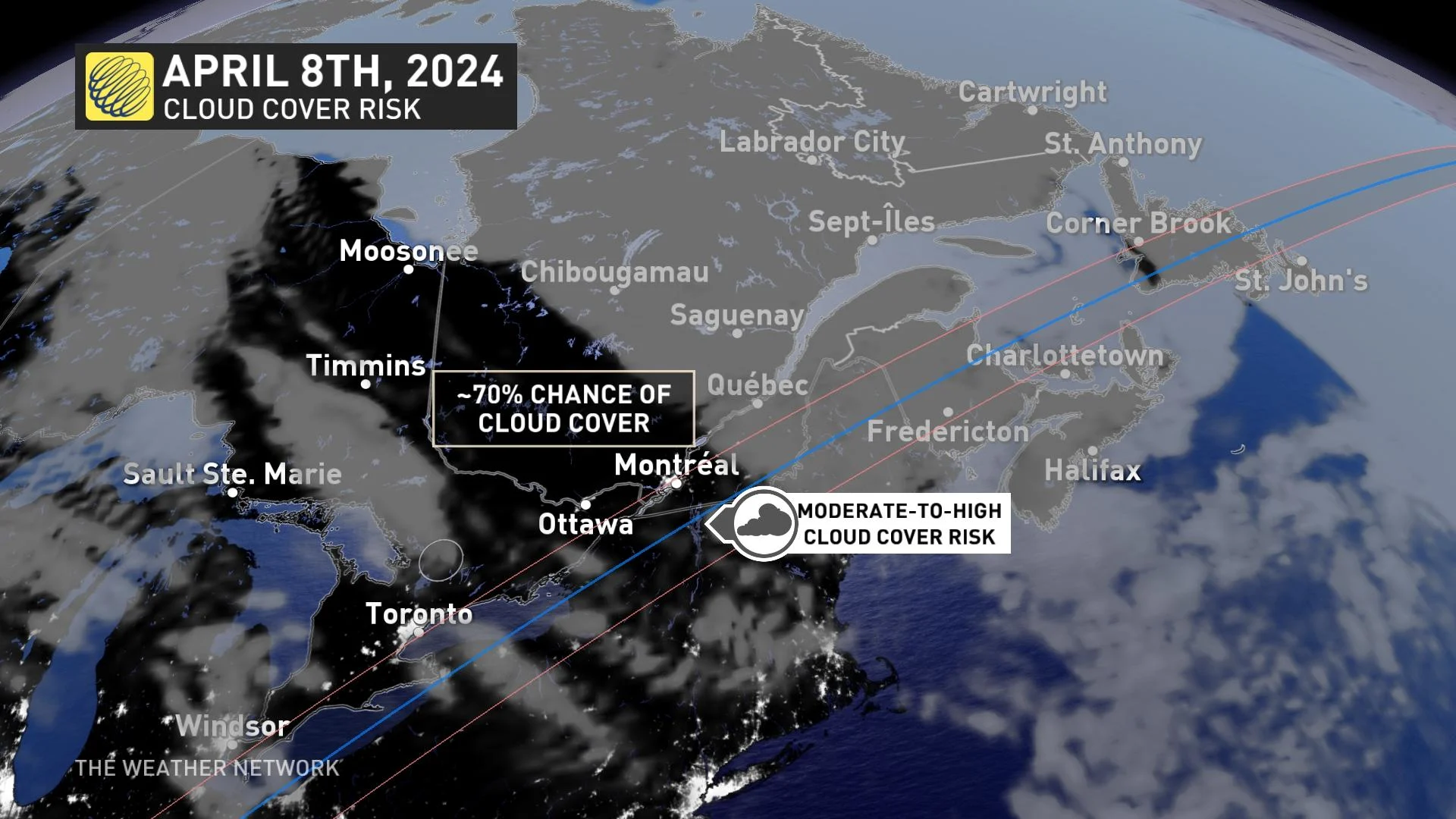
Canada, next year we're in for a once-in-a-lifetime solar eclipse
Make your plans now: A total solar eclipse will dazzle in the skies over Ontario, Quebec, and Atlantic Canada next year.
What are you doing on Monday, April 8, 2024? Whatever you’ve got planned, make sure you’re in Eastern Canada that afternoon for a chance to witness a once-in-a-lifetime total solar eclipse.
That special day will see the Moon pass directly between Earth and the Sun, casting a dark shadow on a tiny strip of land below.
Day will turn dark as night for communities directly beneath the total eclipse’s shadow, with a sunset-like glow lingering on the horizon as you look out of the shadow into the surrounding daylight.

Many Canadian cities—including Hamilton, Kingston, Montreal, Fredericton, Moncton, and Gander—will have a glorious minute or two to gaze up and witness the splendor of the Moon completely covering the Sun, with the Sun’s fuzzy corona dancing around the edge of our orbital companion’s silhouette.
Communities closer to the centre of the shadow will experience totality the longest, while folks near the edge of the shadow may have as little as just a few seconds to witness the sight.
This will be the first total solar eclipse in North America since the eclipse of August 2017 that swept across the length of the United States from Oregon to South Carolina.
Canada’s most recent solar eclipses occurred in August 2008, covering only a small part of Nunavut, and in February 1979, which saw the Moon’s shadow pass over southern Saskatchewan and much of Manitoba, including Winnipeg.
Plan accordingly, though, as folks across Eastern Canada won’t get a chance to see another total solar eclipse at home again until 2079.
The eclipse begins in the tropics
The show begins on the western shores of Mexico not long after noon local time. Folks on the coast will gaze up and see a small nibble of the Sun seemingly disappear, growing until the Moon completely obscures the Sun in a dramatic moment of totality.
A warm spring day will fade to four full minutes of darkness in Mazatlán, Mexico, as the Moon’s shadow makes landfall from the southwest.
DON’T MISS: How to view the ‘ring of fire’ solar eclipse coming in October 2023
A strip of momentary midnight will track northeast over the next 90 minutes as our planet rotates beneath our lunar companion’s bold shadow.
Totality will zip across Mexico in just 20 minutes, crossing the Rio Grande River into Texas around 1:30 p.m. Central Time. The cities of Austin, San Antonio, Dallas, and Fort Worth will all fall into midday darkness as the total eclipse passes directly overhead.
WATCH: Millions of Canadians in the path of 2024’s total solar eclipse
Total eclipse reaches Ontario and Quebec
Observers in southwestern Ontario will begin to notice the Sun’s profile waning in the April sky as the shadow races across the American Midwest, fording the Mississippi and straddling the Ohio River on its way to Canada.
The grand moment of totality reaches Canadian soil at about 3:15 p.m. local time, as the skies over the immediate shores of Lake Erie fall dark under the Moon’s shade. Windsor will just miss totality, and it’ll barely graze Chatham with only a few seconds of total coverage.

Totality will bypass Toronto proper to the southeast by mere kilometres in the following minutes, with the city centre experiencing just a hair shy of totality around 3:20 p.m. local time. Folks in Brantford, Hamilton, and Burlington all stand to see about one minute of darkness.
The Niagara Peninsula will offer the region's best opportunity for a full view of the total eclipse, with more than three minutes of darkness for St. Catharines, Welland, and Niagara Falls.
Farther north and west through the Greater Toronto Area and the rest of southern Ontario, the Sun will appear but a small sliver in the daytime sky near the peak of the eclipse, with daylight noticeably dimming near the time of totality. Barrie will see more than 95 percent of the Sun covered at the peak of the eclipse.
Totality’s complete shadow will continue skirting the international border over the next few minutes, covering Belleville, Kingston, Brockville, and Cornwall before crossing into southern Quebec.
Montreal proper will experience just about one minute of totality around 3:27 p.m., with folks in the Eastern Townships toward Sherbrooke experiencing several minutes of darkness.
SEE IT: 'Ring of fire' partial solar eclipse lights up the sky over Toronto
Vast swath of Atlantic Canada to fall into darkness
It’s worth noting that the eclipse will begin and end faster as its path climbs higher in latitude, as the shadow will begin to glance the side of Earth’s sphere. Totality will last for half as long in Newfoundland as it did in Mexico.
After entertaining portions of Ontario and Quebec, the total eclipse’s path will track into the Maritimes, passing over Fredericton and Moncton in New Brunswick before visiting the western half of Prince Edward Island.

The shadow will cross the Gulf of St. Lawrence and begin sweeping across Newfoundland by late afternoon on April 8, with the eclipse chipping away at the Sun over Port aux Basques a little after 4:00 p.m. local time, and totality arriving about one hour later.
Totality will then head northeast toward Gander, lasting only briefly as the shadow skims the edge of Earth.
Unfortunately for folks in St. John’s, the heart of the eclipse will stay just to the northwest, with totality only arriving for the Bay de Verde Peninsula on the northern tip of the Avalon.
From there, the Moon’s shadow will race into the northern Atlantic Ocean, finally passing off the edge of Earth about halfway between Ireland and the Azores Islands.
This solar eclipse will be a thrilling sight even if you're not near the path of totality. If the weather cooperates, almost all of Canada will be able to see a partial eclipse during the event. More than half of the Sun will slip behind the Moon as far west as Manitoba, and a noticeable chunk of our star will appear blocked out all the way to the West Coast.
Weather is the biggest concern
Weather in April is no walk in the park for much of Canada.
While we’re still hundreds of days from getting even a remote idea of what the weather might be like on April 8, 2024, climatology tells us that the odds are against much of Eastern Canada seeing clear skies on that special afternoon.
Historically, there’s a moderate-to-high risk of cloud cover across the path of totality through Ontario, Quebec, and Atlantic Canada on any given April 8.

Anyone planning to see the solar eclipse in all its glory should keep an open mind and open plans for that afternoon, including the potential to relocate to escape clouds that may eclipse the eclipse.
The shadow itself can also alter the weather beneath the path of totality. Even just a minute or two of totality can appreciably lower the air temperature by as much as 5°C, according to NASA.
The U.S. National Weather Service released multiple balloons in the path of totality in August 2017 to study the eclipse's effects on the atmosphere. Satellite imagery also revealed that fields of puffy cumulus clouds briefly dissipated for a time after the shadow passed overhead.
Total solar eclipses are a rare gem
Total solar eclipses occur during the new moon, or the lunar phase when the Moon’s orbit places it between Earth and the Sun. During this phase, the Moon is only visible during the day as a result of sunlight reflecting off Earth's surface.
Despite the fact that we have a new moon every 29.5 days or so, total solar eclipses are relatively rare. The Moon’s orbit around Earth is slightly tilted compared to Earth’s orbit around the Sun, so the Moon is usually just above or just below the Sun during most new moons.
MUST SEE: Earth just had its shortest day in 60 years
The path of the Moon only passes directly between our home planet and our star to create a total solar eclipse once a year at most, with several years passing between some total eclipses.
It’s more common to experience partial solar eclipses, when the Moon only covers a portion of the Sun, or annular solar eclipses, when the Moon covers the Sun at its farthest distance from Earth, appearing smaller in the sky and leaving a bright ring of the Sun still visible as a result.
This is Canada’s last total solar eclipse for decades
Since the Moon’s shadow covers only a tiny swath of land during a total eclipse, it takes decades—and even centuries—for any one location to see another total eclipse pass overhead.
Canada won’t witness another total solar eclipse until August 2044, when the Moon’s shadow will pass over a large swath of western Canada, including Calgary and Edmonton.
PODCAST: An eclipse in 1900 was one of the first studied by scientists
The path of totality will sweep the Northwest Territories during the evening hours on August 22, 2044, moving south and east over interior British Columbia, most of Alberta, and southern Saskatchewan just before sunset.
Eastern Canada’s next total solar eclipse won’t occur for another 56 years.
An early-morning eclipse will see the path of totality cover all of Nova Scotia and portions of New Brunswick and Prince Edward Island just after 7:00 a.m. local time on May 1, 2079. Totality will sweep north with the rising Sun, pushing into western Newfoundland and eastern Labrador over the next hour.
Safety first!
Total solar eclipses are beautiful. They’re also dangerous. Looking directly into the Sun can seriously damage the retina. Solar retinopathy may heal with time, but long-lasting and sometimes permanent eye damage is possible.
Protection is a must if you plan to view a solar eclipse. Invest in a pair of special and approved solar eclipse viewing glasses designed to protect your eyes from the Sun’s rays while allowing you to see the eclipse firsthand.
There are also other neat tricks to view an eclipse safely, including creating a simple pinhole camera to project an image of the eclipse onto the ground or a wall.
No matter what safe way you choose to view it, next year's total solar eclipse is a sight you won’t want to miss.
Thumbnail image courtesy of NASA.











